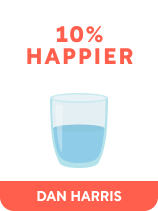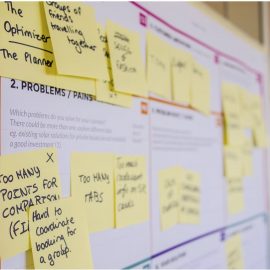

This article is an excerpt from the Shortform book guide to "10% Happier" by Dan Harris. Shortform has the world's best summaries and analyses of books you should be reading.
Like this article? Sign up for a free trial here .
Who does self-help author Dan Harris list as the best self-help authors? What made these authors stand apart from the rest?
Despite finding a few pieces of helpful advice from Tolle, Chopra, and Brach, Harris still had many questions about mindfulness. He eventually found mentors who introduced him to meditation and Buddhism and who helped shape his appreciation of mindfulness.
Three of these gurus were Mark Epstein, Joseph Goldstein, and Spring Washam.
Mark Epstein
The first person who Dan Harris lists as one of the best self-help authors is Mark Epstein. After Harris spent months wrestling with ideas from the previously mentioned self-help gurus, his wife Bianca recommended that he read Mark Epstein’s books. Harris describes feeling skeptical until he saw that Epstein is a trained psychiatrist. As he read Epstein’s work, some ideas reminded him of Tolle’s points. He realized that the ideas from Tolle that most resonated with him were actually rooted in Buddhism.
As Harris describes it, Epstein takes a laid-back, practical approach to Buddhism. Epstein practices meditation and aims to be mindful. He admits that 1) he’s human, 2) he has flaws, and 3) he’s prone to failure, anger, and self-doubt. Harris found Epstein’s approach both encouraging and refreshing, since other gurus exude perfection.
Epstein explains that you should observe your mind and the parts you don’t like about yourself, without trying to change them or accept them—just understand them. If you ignore these negative parts of yourself and your mind, you just give them more power and liberty over your actions.
After reading Epstein’s books, Harris called Epstein to ask if he’d be willing to meet and discuss his ideas. Epstein became a mentor to Harris, and they eventually developed a friendship, meeting regularly. During these meetings, Epstein answered Harris’s questions and helped him through new situations that required mindfulness.
Harris explains that Epstein helped him relax his perfectionist approach to mindfulness. Whenever Harris had a realization, Epstein encouraged his small insights. He also learned that you’re not a failure if you don’t reach enlightenment or don’t always stay in the present moment.
Most importantly, Epstein introduced Harris to meditation. Epstein believes that meditation is the key to developing mindfulness, and he recommended that Harris try it. Harris initially resisted this advice, because he thought meditation was for yogis and spiritualists, not successful journalists.
But eventually, Harris decided to try meditation. He quickly discovered that it was more difficult than he expected—he describes it as mental exercise. Harris stuck with it, though, practicing just a few minutes every day. He started seeing benefits, such as feeling calmer and taking time to appreciate moments as they happened. He kept practicing for several months, gradually increasing his practice to 30 minutes a day. Seeing this progress, Epstein suggested that Harris attend Joseph Goldstein’s meditation retreat to deepen his understanding of meditation, Buddhism, and mindfulness.
| The Importance of a Mentor Epstein mentored Harris on meditation and mindfulness, becoming a resource for Harris to ask for help. With Epstein’s guidance, Harris was able to find answers that worked for his own life. Many experts agree on the importance of having a mentor, because there are numerous benefits of having one. Mentors guide your improvement, share knowledge, and expand your network. They also give advice and encouragement. Mentors don’t cost anything, instead focusing on the value of the relationship, not on a transactional exchange of money. To find a mentor, try looking on social media (like LinkedIn), in professional networks, school clubs, or your HR department. In Never Eat Alone, Keith Ferrazzi offers a few other solutions: Ask your parents or older relatives for connections, or approach a local business owner or professional you admire. |
Joseph Goldstein
Joseph Goldstein is a meditation teacher, author, and a co-founder of the Insight Meditation Society, a meditation retreat center. He was one of Epstein’s Buddhist teachers.
Because of Epstein’s recommendation to go on the retreat, Harris read Goldstein’s books on mindfulness to get a sense of his philosophy. Harris explains that Goldstein believes mindfulness allows you to put space between a stimulant and your emotional reaction. Goldstein’s ideas resonated with Harris, so he took Epstein’s advice to attend the meditation retreat.
The 10-day retreat pushed Harris out of his comfort zone—cell phones and talking were prohibited (except in emergencies), eye contact was discouraged (to avoid interrupting others’ meditative concentration), and snacks weren’t allowed in bedrooms. Harris explains that there were two reasons for these rules: 1) They were intended to strip participants from all of the distractions of daily life, forcing them to truly examine their minds, and 2) they taught attendees that you don’t need cell phones, snacks, or stimulants to feel good—you should create your own inner sense of happiness.
(Shortform note: The renunciation of material items is a common idea in self-help. Minimalism and The Life-Changing Magic of Tidying Up explore this theme, and they led to the mainstream popularity of minimalism as both a philosophy and an aesthetic. Minimalism is the idea of reducing the number of items around you in order to gain mental clarity and simplicity.)
Harris considers the retreat to be one of the most important experiences of his life. During it, he learned about different kinds of meditation and elements of Buddhism. Participants spent almost 10 hours a day meditating. Harris found that challenging at first, but after a few days and some one-on-one meetings with teachers (including Goldstein), Harris noticed improvements in his ability to meditate. The retreat introduced him to new meditation techniques and showed him that meditation in the extreme could enable him to experience euphoria, feel sympathy, and improve his ability to notice his thoughts. Harris says the experience reaffirmed his belief that he was on the right path and that he had found a viable solution to tame his ego: meditation.
| Eat, Pray, Love and the Glamorization of Meditation Retreats Meditation retreats are often associated with insight and personal growth. In Eat, Pray, Love, Elizabeth Gilbert illustrates her transcendental experience learning how to meditate at an Ashram in India. Like Harris, Gilbert describes experiencing discomfort as she changed her relationship with her mind. By persevering through this discomfort, both Harris and Gilbert ultimately benefited from the experience. However, experts warn that accounts of these retreats can lead to glamorization of them, so that people focus on the profound insight a retreat can lead to but ignore the intense process required to get there. They caution that meditation retreats are often uncomfortable for a few reasons: -You’re alone. While there will be other people with you on the retreat, the retreat is designed to isolate you from everything and every one so you can focus on your thoughts. Meditators sometimes feel lonely on retreat. -A meditation retreat may be the first time you sit with your thoughts, free from distractions of day-to-day life. The retreat is designed for you to confront the chaos of your mind so that you can tame it. This can make you feel crazy. -Sitting all day can quickly get uncomfortable, particularly for those who are older, are less flexible, or have chronic pain. By mid-day, meditators report feeling stiffness and sometimes pain. -Mealtime can be uncomfortable. Meditators note that there’s a tendency to obsess over mealtime as a reprieve from sitting or walking. But mealtime, which is typically a social event for people, can be awkward, as you sit silently, avoid eye contact, and listen to the sounds of other people eating. -Leaving the retreat can be overwhelming. After spending so much time away from noise, distraction, and human interaction, meditators caution that being thrust back into a busy, loud world is a jarring experience. The intense deprivation and isolation have led some experts to note that meditation retreats have the potential to do more harm than good. Meditators have reported negative side-effects of retreats, such as perceptual changes, increased anxiety, paranoia, and impaired social skills. Additionally, when participants express concerns about problems they’re experiencing, retreat leaders often dismiss these concerns, instead telling them to push through pain to reach insight. One Buddhist monk also noted another reason these dangers aren’t widely discussed: Retreats are profitable. Meditation retreats can cost thousands of dollars to attend, and on a smaller scale, subscription-based meditation apps have grown in popularity. In April 2020 alone, the top three meditation apps had 6.8 million downloads. As more companies profit off meditation, there’s less incentive to discuss the potential negative effects and more financial incentive to present meditation as a no-risk benefit. |
Spring Washam
Spring Washam was an apprentice teacher at Goldstein’s mindfulness retreat. She led the group through metta, or loving-kindness meditation (we’ll talk more about this later). At first, Harris didn’t like Spring or the meditation she led. He saw her as a stereotypical meditator who hugged trees and ate granola.
But soon, he came to appreciate her messages. While meeting with her, he expressed frustration: He was trying hard to be mindful throughout the meditation sessions, but it wasn’t working. She told him that he was trying too hard and encouraged him to let go of his need for control and perfection in his practice. He realized that it was difficult to be present if you were worrying about being present. Harris explains how after taking Washam’s advice to relax his approach, he reached “choiceless awareness.” This happens when you can release your focus from your breath and simply notice stimuli around you without attaching to it. When he experienced this, he felt like he finally understood that living in the moment is about accepting that each moment is fleeting and coming to terms with impermanence. He felt it was an eye-opening experience.
Later, during another meditation led by Washam, Harris became emotional due to the strong feelings of compassion he felt. Harris describes feeling elated (and also slightly embarrassed), and this feeling continued for the next few days. Harris discovered that he was capable of deep feelings of compassion, finding intense feelings of joy and sympathy for small moments and people he’d never met. This experience made him realize that the benefits of meditation extended beyond managing his ego and easing his stress at work—meditation could also be a tool for personal improvement.
Harris also acknowledges that he was too judgmental of Washam, and he notes at the end of the book that they’re now friends.
| Get Out of Your Comfort Zone Harris initially resisted Washam’s compassion meditation because of his assumptions about her and his discomfort about seeming emotional or compassionate. However, growth often occurs when we can work through our discomfort and get out of our comfort zone. We benefit when we are challenged, by either an idea, person, or situation. Researchers note that by leaving your comfort zone, you can reach your growth zone. You enter your growth zone after overcoming discomfort, fear, and the obstacles of learning new things. Once you reach your growth zone, you’ll be able to meet challenges and problems with confidence and find new goals and purpose. In Can’t Hurt Me, David Goggins echoes this idea that you must get out of your comfort zone to achieve your goals. To do this, try writing down things that you think would make you uncomfortable. Then pick one and try it. If you can do this every day, you’ll build your resilience against discomfort. Another great way to get out of your comfort zone is to challenge your beliefs. Try reading something in a new genre or diversifying who you talk to. |

———End of Preview———
Like what you just read? Read the rest of the world's best book summary and analysis of Dan Harris's "10% Happier" at Shortform .
Here's what you'll find in our full 10% Happier summary :
- A skeptic’s journey through the world of self-help
- How to control your anxiety, manage your ego, and become more compassionate
- How you can improve your life and career—even by just 10%






